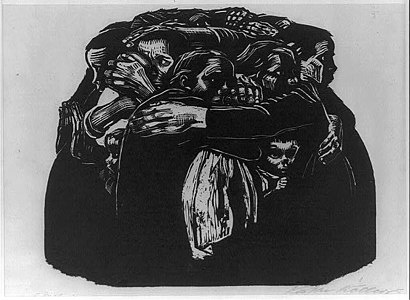
Käthe Kollwitz
Käthe Kollwitz (German pronunciation: [kɛːtə kɔlvɪt͡s] born as Schmidt; 8 July 1867 – 22 April 1945)[3] was a German artist who worked with painting, printmaking (including etching, lithography and woodcuts) and sculpture. Her most famous art cycles, including The Weavers and The Peasant War, depict the effects of poverty, hunger and war on the working class.[4][5] Despite the realism of her early works, her art is now more closely associated with Expressionism.[6] Kollwitz was the first woman not only to be elected to the Prussian Academy of Arts but also to receive honorary professor status.[7]
Käthe Kollwitz
22 April 1945 (aged 77)
2 (including Hans)
Conrad Schmidt (brother)
Johanna Hofer (niece)
Maria Matray (niece)[2]
Pour Le Mérite 1929[1]
Life and work[edit]
Youth[edit]
Kollwitz was born in Königsberg, Prussia, as the fifth child in her family. Her father, Karl Schmidt, was a Social Democrat who became a mason and house builder. Her mother, Katherina Schmidt, was the daughter of Julius Rupp,[8] a Lutheran pastor who was expelled from the official Evangelical State Church and founded an independent congregation.[9] Her education and her art were greatly influenced by her grandfather's lessons in religion and socialism. Her older brother Conrad became a prominent economist of the SPD.[10]
Recognizing her talent, Kollwitz's father arranged for her to begin lessons in drawing and copying plaster casts on 14 August 1879 when she was twelve.[11] In 1885-6 she began her formal study of art under the direction of Karl Stauffer-Bern, a friend of the artist Max Klinger, at the School for Women Artists in Berlin.[12] At sixteen she began working with subjects associated with the Realism movement, making drawings of working people, sailors and peasants she saw in her father's offices. The etchings of Klinger, their technique and social concerns, were an inspiration to Kollwitz.[13]
In 1888/89, she studied painting with Ludwig Herterich in Munich,[12] where she realized her strength was not as a painter, but a draughtsman. When she was seventeen, her brother Konrad introduced her to Karl Kollwitz, a medical student. Thereafter, Kathe became engaged to Karl, while she was studying art in Munich.[14] In 1890, she returned to Königsberg, rented her first studio, and continued to depict the harsh labors of the working class. These subjects were an inspiration in her work for years.[15]
In 1891, Kollwitz married Karl, who by this time was a doctor tending to the poor in Berlin. The couple moved into the large apartment that would be Kollwitz's home until it was destroyed in World War II.[15] The proximity of her husband's practice proved invaluable:







